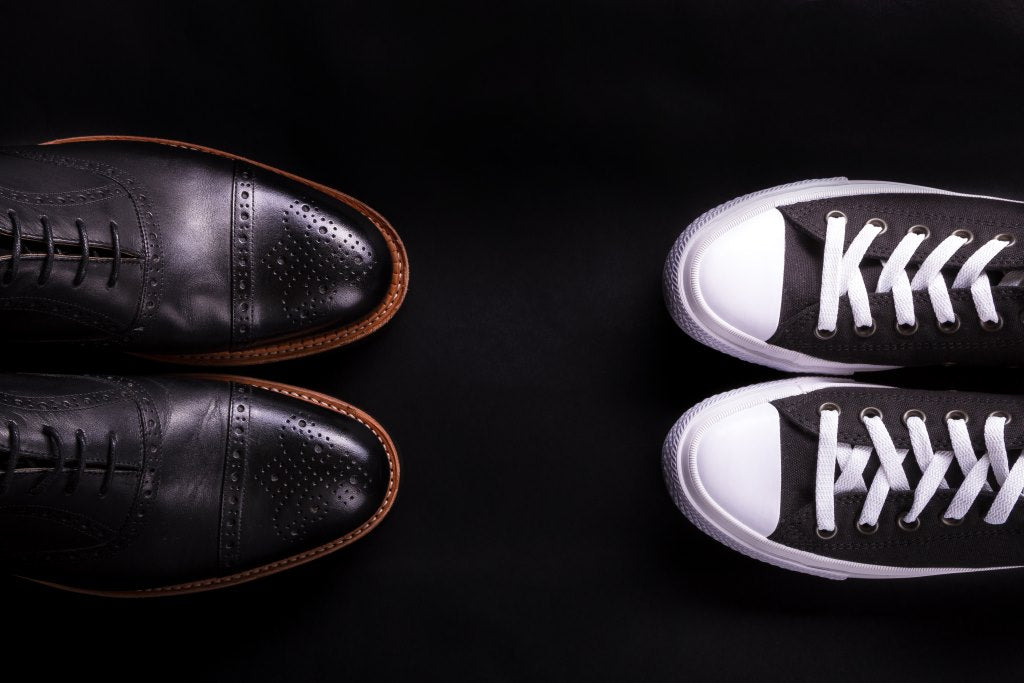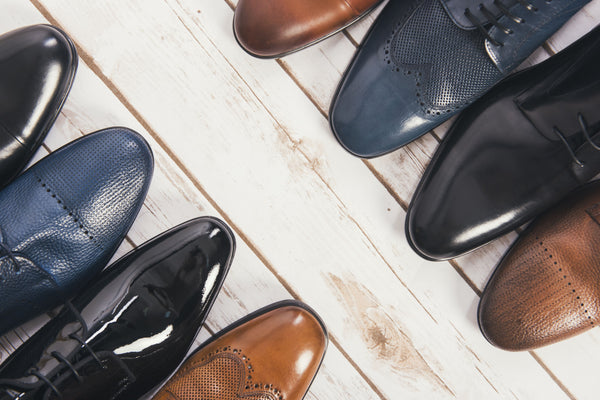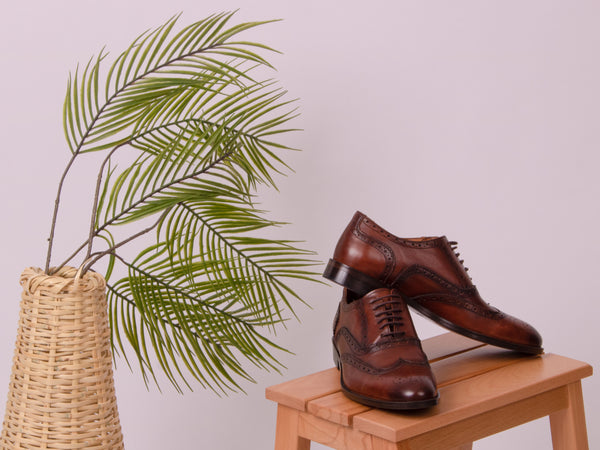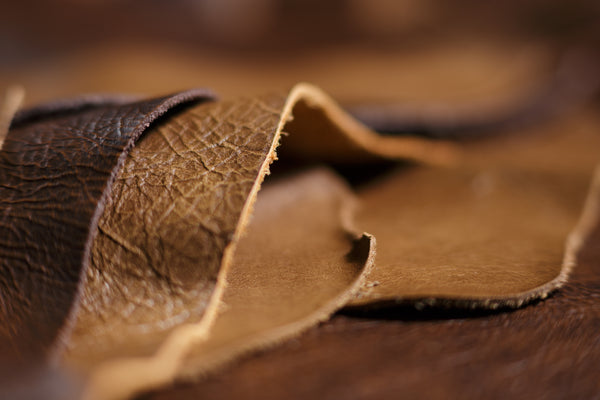About Men's Formal & Casual Shoes: What Makes a Dress Shoe Formal or Casual?
Written By SHILOH BECKETT •

- Difference Between Formal & Casual Dress Shoes
- Secondary Details in Formal & Casual Shoes
- Material
- Color
- Structure
- Soles
- Level of Formality in Formal & Casual Shoes
- A Final Rule of Thumb for Formal & Casual Shoes
Formal & Casual shoes for Men can best be understood by examining their differences. In this guide, you'll find these differences which are grouped into six categories: Structure, Shoe Styles, Color, Material, Secondary Details, Sole, and Level of Formality.
Difference Between Formal & Casual Dress Shoes
Let's proceed with how to decide whether a pair of shoes is formal or casual:
1. Secondary Details in Formal & Casual Shoes
The first method of distinguishing formal and casual shoes is to check some secondary details. Shoelaces and eyelets are perfect examples of such details. Generally, formal shoes are constructed with waxed cotton shoelaces that are thin and round.
In addition, laces sold for formal shoes are thinner and have smaller eyelets than those used for casual shoes – simply due to the smaller eyelets.
Regarding eyelets, their number can also determine formality. For example, a formal shoe usually has five to six pairs of eyelets (in laced form), but a casual shoe doesn't have a specific pattern. Now, let's look at the material aspect of formal & casual shoes for men.
2. Material
Traditionally, leather is the only material that will be used for formal shoes. Alternatively, faux or vegan leather can be used too – as long as the shoes look like leather and meet all the other definitions of formal wear. However, even if they may resemble visually, shoes made with faux leather and other synthetic materials would lack the uniqueness and elegance of leather formal & casual shoes.
The material of casual shoes could be fabric, leather, or a combination of fabric and leather (suede/nubuck). The formality of dress sneakers can be elevated when they are made of leather, even though they remain casual.
Although suede is made of leather, its texture offers a more casual/semi-formal look than formal. However, don't be surprised when you see a suede and patent beauty like this in a highly versatile form.

3. Color
Dress shoes typically come in dark colors, while casual shoes tend to be brighter and more vibrant. The reason for this is simple – it's essential to have formal shoes that are both subtle and presentable.
Color options for formal shoes include black, medium to dark brown, navy blue, and oxblood. On the other hand, the colors of casual shoes are as vibrant as they can get. Colors include yellows, oranges, reds, blues, and turquoise; there are many shades to choose from.
Casual shoes can also be worn in dark colors. The black sneakers are an example that is loved by so many people. Casual shoes in a darker shade, like navy blue suede boots, are another great choice.
4. Structure
Formal shoes differ significantly from casual shoes in terms of their structure. The structure of a shoe refers to the way in which it is constructed, its shape, and its overall appearance.
The shape of formal shoes is compact and sleek since they are meant for dressy occasions. Comparatively, casual shoes such as sneakers tend to be bulkier and have fewer structural elements.
In addition to having sharp lines and clean edges, formal shoes should also share characteristics with other dressy clothing items, such as suits, pants, and shirts, to complete the overall look.
5. Soles
Similar to the upper material, formal shoes traditionally have leather soles, whereas casual shoes have rubber soles. The sole material is not a distinguishing feature, as all formal shoe styles can also be made with rubber soles. The selection of sole material usually depends on other factors, such as sturdiness, comfort, resistance to weather, etc.
Casual and formal shoes differ primarily in the type and appearance of their soles rather than their materials. For example, the sole of formal shoes will have a separate heel part, whereas the sole of casual shoes will be flat (or a small heel drop but not a clear heel part).
There is also a difference in the width of the soles. It is more common for casual shoes to have thicker, chunkier soles, whereas formal shoes will have thinner ones. In some cases, the part of the sole that reaches beyond the sides of the shoe is made as thin as possible.

Thinner soles with separate heels are generally indicate more formal dress shoes
6. Level of Formality in Formal & Casual Shoes
There are two essential factors when considering the level of formality in formal & casual shoes. These are dress codes and occasions. In general, there are four levels of formality in dress shoes:
Casual degree formality
Casual dress shoes are generally intended for everyday use, and compared to ordinary dress shoes, they are less formal and suitable for informal occasions. These occasions are more intimate and relaxed gatherings. Entertaining, socializing, and spending quality time in each other's presence are more or less the main themes of such social events. Therefore, they don't require strict dress codes. These activities include BBQ parties and picnics, brunches, sporting events, leisurely family events, and wedding rehearsals.
Casual dress shoes are manufactured t for everyday use and are not as formal as widely recognized dress shoes. They can be made from leather and fabrics like canvas and suede and generally feature rubber soles. They are suitable for informal gatherings and can be worn with casual clothes like khakis or denim. For the purpose of dress shoes segment and formal & casual shoes discussion, dress sneakers can be located in this category. If you'd like to see what's at the pinnacle of this grade, we suggest taking a look at our collection.
Business Casual Degree
This degree of formality refers to semi-formal occasions. Examples of semi-formal events include business dinners or luncheons, graduation ceremonies, charity events, anniversary celebrations, and home-hosted dinner parties. Typically, semi-formal events call for dress shirts and trousers for men. However, depending on the occasion, accessories like ties and jackets might be a requirement.
Shoes for semi-formal occasions must be of business casual variety. These shoes are overwhelmingly made from leather. The design is relatively plain and in a less polished finish. Both leather and rubber sole can be used throughout the construction process. While it is not mandatory, brown and black are the most frequently used colors.
Loafers are considered generic examples of business casual shoes. However, there is one caveat: their formality level may be up to their designs and material and contextual conditions. Actually, this is an overarching rule when assessing formal & casual shoes. Nevertheless, since they are made of leather rather than suede or canvass and render relatively more simplified and subtle lines, they are considered more formal than sandals and sneakers.
Business formal
Business Formal shoes are intended for more sophisticated events such as job interviews, business meetings with clients, court appearances, conferences, and seminars. These shoes are usually crafted with superior quality leather with a glossy look and leather soles. Other details like a wingtip or cap toe may also be present, and they come in the classic shades of black or brown. So Oxford, Derby, Monk Shoes, and some sub-designs of loafers are the proper fit for business formal events.
Black Tie
For the most formal occasions, such as black-tie events, men's dress shoes of the black-tie style are appropriate. These shoes are usually constructed of highly polished patent leather with a leather sole. Decorative touches like a bow or tassel can be included, and they come in classic colors, such as black.
Black tie events' guests must dress in a formal and elegant outfits. Weddings held in formal venues, operas and theatre shows, galas, and balls, award ceremonies like Nobel, Oscar, and Emmys, and charity events are a few examples of black tie events that usually require black-tie dress codes.
Patented leather oxford shoes, dress boots, and velvet slippers and brogues can be combined with tuxedos for these types of occasions.
A Final Rule of Thumb for Formal & Casual Shoes
We hope our blog regarding the gist of formal & casual shoes for men helps discern what is best for you. However, when in hesitation, it is always wiser to opt for being too formal than being too casual.
Follow Us
Inspired by its native soil in Europe, where not only the continents but also many magnificent civilizations meet, Debbano gathers peerless sophistication, beauty, artistry, and, ultimately, the gloriousness of the best quality leather with its unique patterns and identity.
Follow us to be updated about style, colors, materials and construction techniques, fashion, lifestyle, and much more, covering the context of men’s leather dress shoes. You can visit our website and/or follow our Instagram and YouTube channels.





